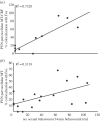Involvement of different mesotocin (oxytocin homologue) populations in sexual and aggressive behaviours of the brown anole
- PMID: 25165455
- PMCID: PMC4155917
- DOI: 10.1098/rsbl.2014.0566
Involvement of different mesotocin (oxytocin homologue) populations in sexual and aggressive behaviours of the brown anole
Abstract
The oxytocin (OT) family of neuropeptides are known to modulate social behaviours and anxiety in mammals and birds. We investigated cell numbers and neural activity, assessed as Fos induction, within magnocellular and parvocellular populations of neurons producing the OT homologue mesotocin (MT, Ile(8)-oxytocin). This was conducted within the male brown anole lizard, Anolis sagrei, following agonistic or courtship encounters with a conspecific. Both neurons colocalizing and not colocalizing corticotropin-releasing factor (CRF) were examined. Parvocellular neurons of the paraventricular nucleus exhibited a positive correlation between courtship frequency and Fos colocalization, regardless of whether they produce just MT or MT + CRF. Magnocellular populations showed only trends towards positive relationships with courtship and no cell populations showed aggression-related Fos induction. These findings are novel because they demonstrate the involvement of MT neurons in male social behaviour, especially in reptiles for whom the involvement of MT in social behaviour was previously unknown.
Keywords: aggression; anole lizard; corticotropin-releasing factor; courtship; mesotocin; oxytocin.
© 2014 The Author(s) Published by the Royal Society. All rights reserved.
Figures


Similar articles
-
Neural activity in the social decision-making network of the brown anole during reproductive and agonistic encounters.Horm Behav. 2018 Nov;106:178-188. doi: 10.1016/j.yhbeh.2018.06.013. Epub 2018 Oct 26. Horm Behav. 2018. PMID: 30342012
-
Aggression- and sex-induced neural activity across vasotocin populations in the brown anole.Horm Behav. 2013 Mar;63(3):437-46. doi: 10.1016/j.yhbeh.2012.11.016. Epub 2012 Nov 30. Horm Behav. 2013. PMID: 23201179
-
Neural activity in catecholaminergic populations following sexual and aggressive interactions in the brown anole, Anolis sagrei.Brain Res. 2014 Mar 17;1553:41-58. doi: 10.1016/j.brainres.2014.01.026. Epub 2014 Jan 25. Brain Res. 2014. PMID: 24472578
-
Central vasopressin and oxytocin release: regulation of complex social behaviours.Prog Brain Res. 2008;170:261-76. doi: 10.1016/S0079-6123(08)00422-6. Prog Brain Res. 2008. PMID: 18655888 Review.
-
The role of oxytocin and the paraventricular nucleus in the sexual behaviour of male mammals.Physiol Behav. 2004 Nov 15;83(2):309-17. doi: 10.1016/j.physbeh.2004.08.019. Physiol Behav. 2004. PMID: 15488547 Review.
Cited by
-
Neural systems that facilitate the representation of social rank.Philos Trans R Soc Lond B Biol Sci. 2022 Feb 28;377(1845):20200444. doi: 10.1098/rstb.2020.0444. Epub 2022 Jan 10. Philos Trans R Soc Lond B Biol Sci. 2022. PMID: 35000438 Free PMC article. Review.
-
Serotonergic activation during courtship and aggression in the brown anole, Anolis sagrei.PeerJ. 2017 May 16;5:e3331. doi: 10.7717/peerj.3331. eCollection 2017. PeerJ. 2017. PMID: 28533977 Free PMC article.
-
Oxytocin has 'tend-and-defend' functionality in group conflict across social vertebrates.Philos Trans R Soc Lond B Biol Sci. 2022 May 23;377(1851):20210137. doi: 10.1098/rstb.2021.0137. Epub 2022 Apr 4. Philos Trans R Soc Lond B Biol Sci. 2022. PMID: 35369742 Free PMC article. Review.
-
Effects of Social Information on the Release and Expression of Gonadotropin-Inhibitory Hormone in Birds.Front Endocrinol (Lausanne). 2019 Apr 24;10:243. doi: 10.3389/fendo.2019.00243. eCollection 2019. Front Endocrinol (Lausanne). 2019. PMID: 31068902 Free PMC article. Review.
-
Spot the difference: Solving the puzzle of hidden pictures in the lizard genome for identification of regeneration factors.BMB Rep. 2016 May;49(5):249-54. doi: 10.5483/bmbrep.2016.49.5.045. BMB Rep. 2016. PMID: 26949021 Free PMC article. Review.
References
MeSH terms
Substances
LinkOut - more resources
Full Text Sources
Other Literature Sources

